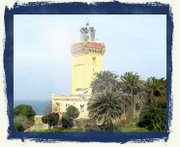He has already been involved with many great projects, including the Gotthard Pass tunnel in Switzerland and the Mont Blanc tunnel which links France and Italy.
But he says this one may be his toughest assignment yet.
"No works in the world compare to this one," he said.
"There are a lot of challenges. First of all the sea at this point is 300m (1,000ft) deep - about five to six times deeper than the Channel Tunnel [linking the UK and France].
"Then there is the geological conditions. There are quite a lot of tectonic movements between the African and the European plates. So there would be quite a lot of movements in the earth, of stresses and so on."

On a cliff top outside Tangier stands a rusty frame with cables and weights. It may not look very much but this is the start of a shaft that descends 300m below sea level, and this is where scientists and engineers are examining the sea bed to see how difficult it will be to drill into the rock.
The team is lead by engineer Jillali Chafik from the Moroccan research team SNED.
"At the moment we are carrying out the last studies into the sea bed which hold the key for the railway tunnel," he said.
"These studies should be finished by the end of 2007. We are looking at how the tunnel will actually work and the amount of traffic that will use the tunnel, once it starts."

Political will
The blueprint for the tunnel envisages two tubes for train lines beneath the Strait of Gibraltar, with an emergency or service tunnel in between them.
Like the Eurotunnel project, the trains would carry passengers as well as cars.

It has been talked about since the early 1980s, but the Moroccans say this time there is the political will. They are now in the final stages of the feasibility study which will be completed by the end of the year, with construction starting soon after.
Spanish Prime Minister Jose Luis Rodriguez Zapatero recently visited Morocco and said that Spain was fully committed to the project.
"It will be a great symbol of our times," he said.
"It will change the face of Europe and Africa. With support from members of the European Union, we can build this historic connection between the two continents."
Morocco's minister for transport, Karim Ghellab, says there would be huge economic benefits for his country.
"It's clearly desirable that Morocco and Africa are joined to Europe by a fixed link," he told me.
"It would ease communications between the two, and allow passengers and goods to move easily between the two continents. It's an historic project which the world needs today and it will go ahead," he said.
Bankruptcy fears
That is the official line, but ordinary Moroccans remain sceptical.
The fortunes of the Channel Tunnel were followed closely here, and people have read the bad press about massive cost overruns, and desperate attempts by immigrants to cross into the UK from France.
A group of students pointed out some of the downsides of a tunnel.
"I wonder if the problem of illegal immigration will be solved or not. By the time the tunnel is built young people will see the tunnel as a chance to run away," one said.
"It will take a lot of money away from Morocco where we have so many problems - like poverty and unemployment," said another.
"You can see what happened to the tunnel between England and France and the company almost went bankrupt so you can imagine what would happen to Moroccan companies if they participated in such a project".
But scientists and politicians on both sides of the Mediterranean now seem convinced that the design will become a reality.
The big question is where the money will come from. Estimates of cost vary between $8bn and $13bn (£4.1bn - $£6.7bn).
It is hoped that funding can be raised via two publicly owned companies in Spain and Morocco, as well as financial support from the European Union.
If the money is forthcoming, the very first fixed link between Europe and Africa could become one of the modern wonders of the world.
thanks to Richard Hamilton BBC News, Tangier


























